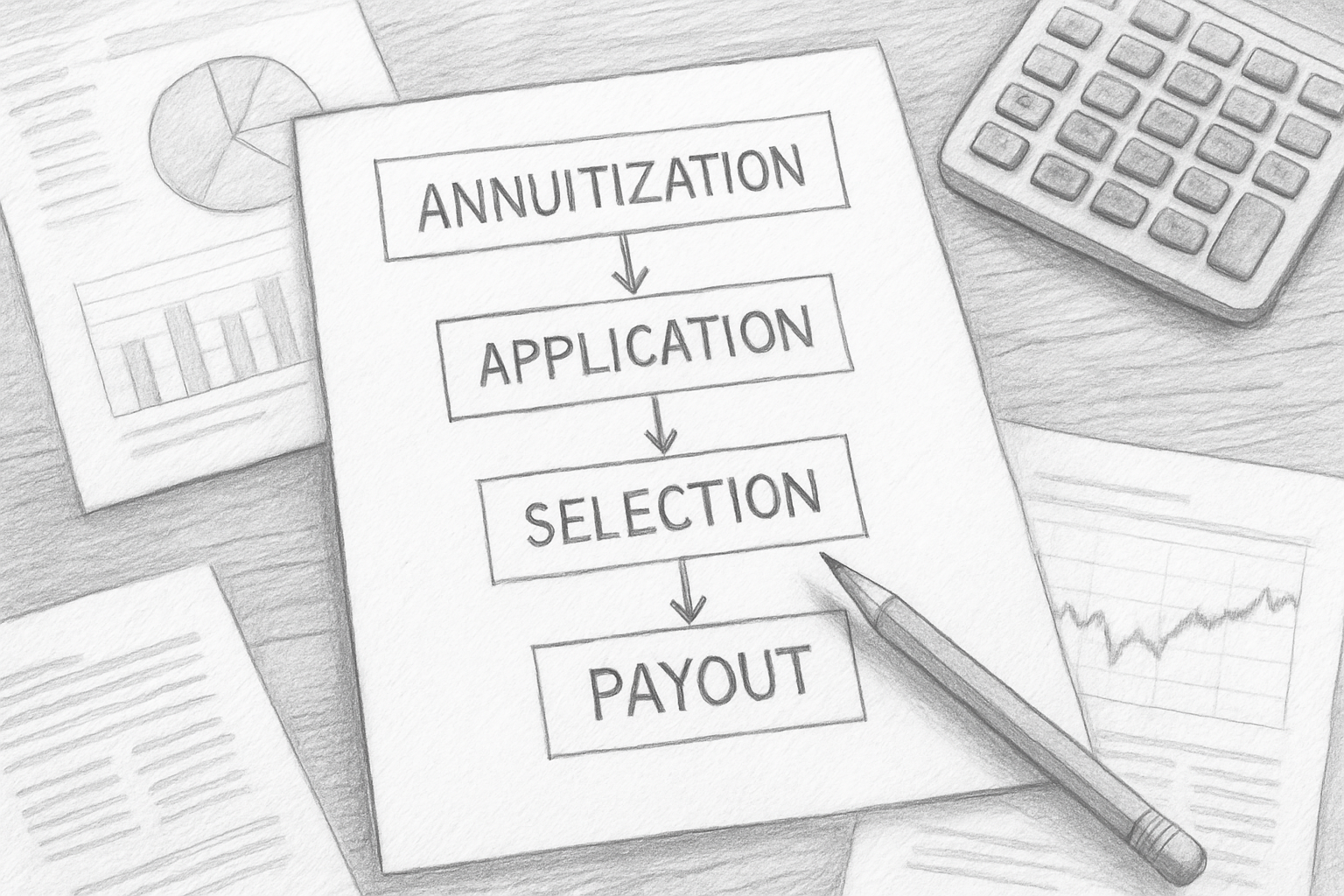
Key Highlights
- The annuitization process is a financial strategy converting retirement savings into guaranteed income that can support you throughout your retirement.
- Comparing annuitization with traditional withdrawals reveals crucial differences in steady income versus flexible access to funds.
- Various payout options, including life annuities or period certain annuities, allow customization based on retirement goals and risk tolerance.
- Lifelong guaranteed income eliminates worries about outliving your savings, fostering peace of mind in retirement.
- Potential drawbacks, such as reduced liquidity and inflation effects, should be carefully evaluated before committing.
- Answers to common questions regarding tax implications, payout options, and annuity contract terms help clarify the annuitization decision-making process.
Introduction
Planning for a safe retirement income can feel hard at times. This is true when you think about how long you might live or when money times get tough. The annuity contract can help with this. Through something called annuitization, it takes your saved money and turns it into a stream of steady income. That way, you get more peace about your money, year after year. To use annuitization in the best way, you need to know how it works and see how it fits with your whole retirement plan. Let’s look at how it helps you get steady income and peace with your retirement.
Understanding Annuitization and Its Role in Retirement
 When you get ready for retirement, it is important to have a steady income stream. The annuitization process can help with this. It turns the money you have in an annuity into periodic payments. These payments match your retirement goals. You can set them up to last for your whole life or just for a certain amount of time. Annuitization gives options that fit what you need.
When you get ready for retirement, it is important to have a steady income stream. The annuitization process can help with this. It turns the money you have in an annuity into periodic payments. These payments match your retirement goals. You can set them up to last for your whole life or just for a certain amount of time. Annuitization gives options that fit what you need.
Also, annuitization can help protect you in retirement. You do not have to worry about outliving your savings or what happens if the market goes up and down. The payments are regular, so you have a dependable base of money. This makes it easier for you to enjoy retirement without worry. Now, let’s look at what annuitization means.
What Is Annuitization?
Annuitization is when you turn an annuity investment into periodic income payments. With this, you get guaranteed income for a period of time or as long as you live. Insurance companies offer annuitization to help people have income security after they stop working. You first put money in, and then later, you can turn that cash value into regular income.
The special thing about annuitization is that these income payments stay steady no matter what is happening in the market. After you decide you want to annuitize, your annuity’s cash value changes to become regular income. That means you can count on the money you come to get every time.
When choosing to do annuitization, you be able to pick certain options in the contract. You might set how long you get payments, maybe for a certain period of time or even for how long you live. This way, you get income stability for you and your family, but at the same time, you give up some control over your annuity investment. It’s good to know the details about annuitization so you can get the most from it and also understand any drawbacks.
Annuitization vs. Withdrawals: Key Differences
Choosing between annuitization and withdrawals from your retirement funds depends on what each option provides.
- Annuitization gives you a steady income stream. You will get fixed or changing payments for a set time.
- Withdrawals, on the other hand, let you take out large sums. This means you have more freedom in how you use the money.
- Annuitization can help you not run out of money during your life. Withdrawals do not offer the same safety net.
- With annuitization, the amount you get is steady. If you just use withdrawals, the amount you get is tied to how much is in your account.
If you want more control and need cash when you want it, withdrawals might be for you. If you want a steady income for life, annuitization might fit better. Knowing how each works can help you pick the best way to meet your financial goals. This way, you can have a stable income in retirement.
How the Annuitization Process Works
 The process of annuitization is when savings in an annuity are changed into regular periodic payments during the payout phase. First, you reach the annuitization date. This means you move from the accumulation phase to the next step.
The process of annuitization is when savings in an annuity are changed into regular periodic payments during the payout phase. First, you reach the annuitization date. This means you move from the accumulation phase to the next step.
After this, the insurance company will work out how much each payment will be. The company uses your contract value, your life expectancy, and the payout option you choose. Payments can come to you every month, every three months, or once a year. This way of getting money gives you and other people a stable income for the future. That is why annuitization is seen as a powerful tool for retirees who want steady income.
Reaching the Annuitization Date
The annuitization date is when you stop saving during the accumulation phase and begin to get payouts. The time you reach this depends on your contract value and what kind of annuity you have.
When you have deferred annuities, the annuitization date is normally 10–15 years after you buy it. You can start taking money out anytime after you reach this time. With an immediate annuity, payouts start right away after you put in the lump sum.
It is important to plan the start of payouts so it matches your financial goals. If you start taking money too soon, you will get less. If you wait longer, you may get more, but you might not live long enough to use it. Choosing when to start getting payments helps make sure your retirement plan works well and fits you.
Choosing Your Payout Options
Choosing the right payout option is important if you want your annuity to match your life and goals. There are a few main choices you need to know about:
- Lifetime: You get guaranteed income payments for as long as you live. This is great for people who want security in knowing they will not run out of money.
- Period Certain: Your payments come in for a set number of years. If you pass on early, payments will still go to your loved ones. This lets you leave something behind.
- Joint and Survivor: This option means both you and your partner will keep getting regular income. Payments stay steady for your life and also for your survivor.
- Variable Annuities: These payouts may go up or down. It depends on how the investments do. They can help if you worry about money losing value over time.
To make the best choice for you, think about things like your risk tolerance, how long you need payments to last, and what is most important for you and your family. Talk to a financial advisor to understand all your options well. This will help you reach your retirement goals and get the most out of guaranteed income and regular income.
Types of Annuitization Payout Options
Annuitization gives you many ways to get paid. This means you can pick what works best for you and your money needs. The type of annuity you choose, along with things like the annuity payout amount and how long you want to get paid, shapes what your income stream will look like.
You can pick from steady payments for life, payouts that increase with inflation, or payments for a set number of years. When you look at all these choices and think about your own goals, you can pick an option that fits well with your retirement savings plan. Now, let’s look at two well-known kinds of annuities and see how they compare.
Life Annuity vs. Period Certain Annuity
Choosing between life annuities and period certain annuities may change the way you get retirement income. Below is a clear look at both options:
| Feature | Life Annuity | Period Certain Annuity |
|---|---|---|
| Guaranteed Income | You get income payments for your whole life. | Income payments last only for a set time, like 10 or 20 years. |
| Legacy Benefit | There is no payment for others after you die. | Any left-over guaranteed income goes to your chosen person. |
| Payment Amount | The payment amount is higher because it may last your whole life. | Payment amount is lower because the time is set. |
| Longevity Risk | You do not need to worry about outliving income—you are safe for life. | Longevity risk is covered only for the set time period. |
To choose, think about if you want guaranteed income payments that last your whole life, or if you need only a set amount of time for a financial safety net. What you pick will depend on your plan and needs.
Joint and Survivor Annuity Choices
Joint and survivor annuities give steady regular income payments not just to the retiree, but also to a chosen survivor. This is often a spouse.
This payout option is good for long-term security. It keeps making payments as long as either person is alive. When you look at single-life annuities, you will see the monthly payouts are higher. But for joint and survivor annuities, the payouts are smaller because they last longer and cover two lives.
Annuity providers set the payment amount based on the types of annuities you pick, the contract details, and how old the recipients are. For couples, this setup is good if they want to keep money coming in throughout the later years of their life. They get the peace of mind knowing their regular income does not run out too soon.
Benefits and Drawbacks of Annuitization
Annuitizing your retirement plan can be very helpful for many people. The annuity payments give you a steady stream of money for life. This means you do not have to worry about outliving your savings. But, when you decide to start getting these payments, you lose easy access to the cash value in your plan. You also cannot change how you use your money as easily.
It is important to think about these good and bad points before you make a choice. You want to be sure this fits your plans and needs. Next, we will talk about the main reasons why getting lifetime income can be a good thing. After that, we will look at some things that may not be as good.
Advantages of Securing Lifetime Income
Turning your retirement savings into lifetime income gives you many benefits:
- Guaranteed Stream of Payments: You get steady money each month or every few months, so your finances stay steady.
- Peace of Mind: You know your money will not run out, so you feel better about the future.
- Higher Payouts: If you wait to start getting your payments, the payments can be bigger.
- Shield Against Longevity Risk: A steady lifelong income means you will have enough money even if you live longer than you think.
With this kind of money setup, people in retirement can focus on enjoying life, knowing the income from their retirement savings will not stop.
Potential Downsides and Limitations
When you go through annuitization, you get steady income, but there are some things you should know:
- Loss of Flexibility: After you start, you cannot change your payment amount. You also cannot get money from the principal.
- Inflation Effects: If your payments stay the same for years, they may not go as far because prices go up.
- Ordinary Income Taxes: These payments are taxed like regular pay. This lowers how much money you really get.
- Death of the Owner: For single-life annuities, if the owner dies, payments stop. There will be no money left for anyone else.
Looking at these limits will help you see if annuitization is right for your whole money plan.
Conclusion
To sum it up, knowing about annuitization is important if you want to have steady money in retirement. When you look at the payout options and think about what is good or bad with each, you will be able to make smart choices that match your financial goals. Some people pick a life annuity for guaranteed income. Others may look at different options depending on what works best for them. It is important to see how each option will fit into your retirement plan. If you want to learn more about these choices, you can get a free consultation to talk about annuitization and find the best way for your financial future.
Frequently Asked Questions
What are the tax implications of annuitization?
The annuity payments that you get count as ordinary income. This is because of the money your annuity contract earns. Taxes only apply to the part of your income plan that grows over time. Any money you put in your annuity contract before that was already taxed is not taxed again.
Can I change my payout option after annuitizing?
No, once the payout option in an annuity contract is chosen, it usually cannot be changed. The annuity owner will not be able to change the guaranteed income plan or get to the contract value once the payments begin.
How does inflation affect my annuity payments?
If you do not have changes for inflation, fixed annuity payments will lose their value over time. When interest rates and prices go up, the payment amount you get will buy less. This can hurt how well your income plan works.
Is annuitization right for everyone?
No, it depends on your risk tolerance, retirement goals, and what is most important for you when it comes to money. Talking to a financial advisor can help you see if annuitization matches up with your need for a steady income stream.
What happens to my annuity if I pass away early?
If the death of the owner happens before all annuity payments are made, a beneficiary will get the rest of the cash value or money. This will be done for a specific period, which is stated in the annuity contract.

